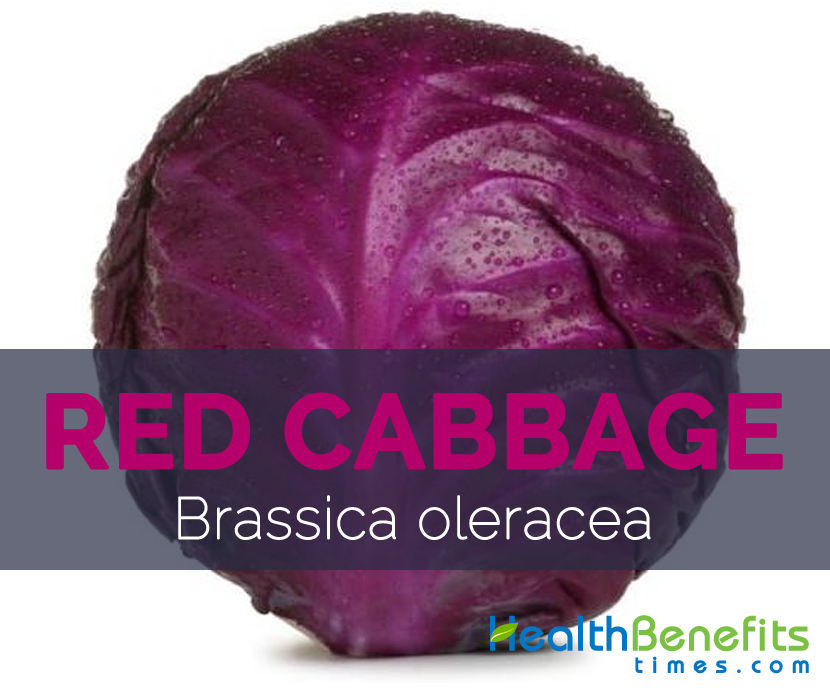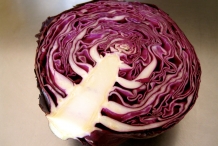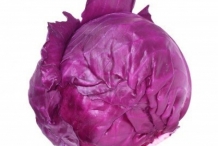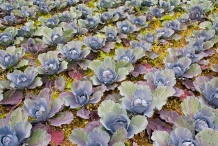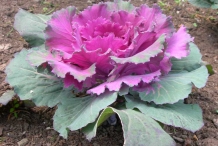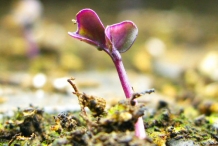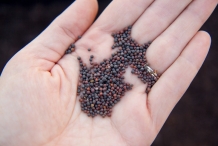Plant
Red cabbage is a biennial plant grown as an annual vegetable crop. It is normally 40–60 cm (16–24 in) tall in first year, and 1.5–2.0 m (4.9–6.6 ft.) tall when flowering begins. It is a seasonal vegetable which grows well in cool weather. It prefers well-drained, nutrient-rich soil that’s high in organic matter. Roots are usually thin taproot and cordate (heart-shaped) cotyledons. Leaves are ovate (egg-shaped) with a lobed petiole. Inflorescence is an un-branched and unspecified terminal raceme measuring 50–100 cm (20–40 in) tall, with flowers that are yellow or white. Each flower has four petals set in a perpendicular pattern. The rich red color of red cabbage is because of its concentration of anthocyanin polyphenols. Additionally, the juice of red cabbage is used as a home-made pH indicator, which turns red in acid and green/yellow in basic solutions.
Fruit
Red cabbage is a healthful and delightful vegetable that is very popular all through the world for a number of reasons. Cabbage head is normally 0.5 to 4 kilograms (1 to 9 lb) in weight. Leaves of the red cabbage are usually Dark red/purple colored. With thicker leaves that have a faintly peppery taste, red cabbage has a tendency to keep longer than its green cousin. Cabbage pod is a silique which opens at maturity through dehiscence to disclose brown or black seeds that are small and round in shape. Just like green cabbage, it can be used raw or cooked. Its sweet-spicy flavor and brilling color make it delicious in several dishes. Red cabbage normally turns pale blue as soon as heated. To hold its lively red color throughout cooking, add a few amount of vinegar or lemon juice, or cook the vegetable along with acidic ingredients such as apples or wine.
History
Red cabbage’s origins are exactingly European. Hard-heading type of cabbages are believed to have been first produced in Europe by Nordic and Celtic cultures. The round-headed form is the oldest of the hard types of cabbage but it is only one described first during the 16th century. Around 600 B.C. wild cabbage was brought to Europe by groups of Celtic wanderers. Red cabbage dates back to 1570 in England; however it was introduced to all of Europe by the Romans during the 14th century. It was used mainly by peasant families as food for both human and livestock consumption during 14th century. During 18th century Red cabbage first appeared in an aristocratic culinary setting and it is now grown internationally and traded throughout all hemispheres.
Health benefits of Red cabbage
Red cabbage has 10 times more vitamin A and twice as much iron as green cabbage. Regular intake of red cabbage will help you to remain healthy and active.
1. Cancer Prevention
Red cabbage plays an important role in Cancer prevention due to the presence of high levels of antioxidant components as a preventative measure. Antioxidants are actually the substances that can neutralize free radicals that are the harmful byproducts of cellular metabolism. These free radicals are actually liable for numerous serious diseases, like heart disease, cancer and many more. As mentioned previously red cabbage is rich in antioxidants like anthocyanins and indoles. The rich coloring is proof of just how powerful these vegetables are for your overall health. Research show that Indoles present in red cabbage have been related to reducing breast cancer in women. Additionally Vitamin A is also related with reducing the chances of lung cancer.(1), (2)
2. Weight Loss Aid
Red cabbage is very low in calories and high in dietary fiber and is full of essential vitamins and minerals. Consumption of red cabbage will make you feel full and take care of your nutritional requirements, without encouraging you to eat more food or overeat from empty calories. So this can be an excellent addition in your daily diet in case you are attempting to lose weight, maintain a diet regimen, or just increase your intake of calories.(3)
3. Premature Aging
Numerous features of red cabbage make it ideal for making you young. Different antioxidants that are present in Red cabbage help to protect you from effect of free radicals in terms of serious disease. Apart from that it will also help to reduce the ageing sign which occur because of free radicals. It also helps to keep skin tight, fresh and flexible, reduce age spots and wrinkles which occur as we grow old. Additionally considerable amount of vitamin A present in Red cabbage is valuable for regrowth of skin cells, skin health, protection from sun damage and elasticity of the skin.(4)
4. Eye Health
Vitamin A is not only good for your skin, but also for eyes. Macular degeneration and cataract formation can be prevented with the regular consumption of Vitamin A rich foods regularly. Vitamin A can also be converted into beta carotene that is essential for sustaining eye health as you grow old.(5)
5. Ulcers
Amino acid namely glutamine which is present in huge amount in red cabbage are beneficial for decreasing inflammation as well as pain related with ulcers in gastrointestinal systems. Regular consumption of red cabbage juice is the best remedy for such conditions and also has been used as a home cure for a very long time.(6)
6. Alzheimer’s disease
Alzheimer’s disease is mainly noticed as we grow old. Different research has been done to find preventative measures and cures for this disease for several years. Red cabbage is discovered to be very powerful in protecting the cognitive activity of people. Development of particular type of plague is in fact a main reason for cognitive loss in those patients. Anthocyanins found in red cabbage definitely decrease the occurrence of this plaque, safeguarding brain against this awful disease.(7)
7. Bone Mineral Density
High concentration of certain minerals present in red cabbage makes it one of the best vegetable options to guarantee healthy bone growth and development. Red cabbage consists of considerable amount of magnesium, calcium, manganese as well other essential minerals which are essential for proper growth and development of bones and also prevents many bone related problems like arthritis, osteoporosis and various types of inflammation.(8)
8. Premenstrual Syndrome
Vitamin B6 present in red cabbage has a important part to play for the treatment of premenstrual syndrome occurring in women. Pyridoxine is reduced throughout this period, therefore leading to loss of sex drive, moodiness and other problems. For such situation, consumption of a diet rich in Vitamin B6 is the most effective solution.
9. Sugar level
Red cabbage consists of considerable amount of manganese that showed efficiency in controlling the level of sugar which further prevents the incidence of certain diseases like diabetes. Manganese regularizes insulin synthesis and secretion, and the unpredictable drops in blood sugar can be better regulated, offering normal and practical life for diabetics.
10.Regularizes bowel movements
Red cabbage consists of Dietary fiber which helps to boosts the weight and size of stool and softens it. Large stool is easier to pass, lessening the chance of constipation. In case you have watery stools, fiber helps to solidify the stool since it absorbs water and adds bulk to stool.
How to Eat
- Red cabbage is frequently used raw for salads and coleslaw.
- It can also be eaten cooked.
- It can be traditional supplementary side dish paired along with several German meals—most probably, Sauerbraten.
- It can be spiced and served as an accessory to seasonal roast goose at Christmas.
- They are boiled, steamed, pickled and stir-fried.
- German sauerkraut and Korean kimshi are made from fermented cabbage.
- Outer leaves are stuffed and used to wrap other foods just before baking or braising.
- It is frequently pickled fresh and made into sauerkraut.
Other Facts
- Red cabbage is used as a natural dye for cloth or food.
Precautions
- It is recommended to stay away from red cabbage in case you suffer from hypo-thyroidism.
- Babies frequently develop colic in case if their mothers consume cabbage, so most doctors recommend not consuming red cabbage while pregnant.
Reference:
https://en.wikipedia.org/wiki/Red_cabbage
Comments
| Red Cabbage Quick Facts | |
|---|---|
| Name: | Red Cabbage |
| Scientific Name: | Brassica oleracea |
| Origin | Origins are strictly European |
| Colors | Origins are strictly European |
| Shapes | Standard round to flattened or pointed |
| Taste | Faintly peppery taste |
| Calories | 22 Kcal./cup |
| Major nutrients | Vitamin K (29.75%) Vitamin C (28.67%) Vitamin B6 (13.00%) Manganese (7.26%) Iron (6.25%) |
| Health benefits | Normalizes bowel movements, Sugar level, Premenstrual Syndrome, Bone Mineral Density, Alzheimer’s disease, Ulcers, Eye Health, Premature Aging, Weight Loss Aid, Cancer Prevention |
| Name | Red cabbage |
|---|---|
| Scientific Name | Brassica oleracea |
| Native | Origins are strictly European |
| Common/English Name | Purple cabbage, red kraut, blue kraut |
| Plant Growth Habit | Biennial plant but grown as an annual vegetable crop |
| Growing Climate | Easy to grow in cool weather |
| Soil | Well-drained, nutrient-rich soil that’s high in organic matter |
| Plant Size | 40–60 cm (16–24 in) tall in first year, and 1.5–2.0 m (4.9–6.6 ft) tall when flowering begins |
| Root | Thin taproot and cordate (heart-shaped) cotyledons |
| Leaf | Leaves are ovate (egg-shaped) with a lobed petiole. |
| Flower | Inflorescence is an unbranched and unspecified terminal raceme about 50–100 cm (20–40 in) tall,with flowers that are white or yellow. Each flower has four petals set in a perpendicular pattern |
| Cabbage Head shape & size | Standard round to flattened or pointed |
| Cabbage Head Weight | 0.5 to 4 kilograms (1 to 9 lb) |
| Cabbage Head color | Dark red/purple |
| Cabbage Head Flavor/aroma | Bitter, peppery flavor |
| Cabbage Head Fruit Taste | Faintly peppery taste |
| Cabbage Pod | Pods are silique |
| Cabbage Seed | Brown or black seeds, small and round in shape |
| Major Nutrition | Vitamin K (phylloquinone) 35.7 µg (29.75%) Vitamin C (Ascorbic acid) 25.8 mg (28.67%) Vitamin B6 (Pyridoxine) 0.169 mg (13.00%) Manganese, Mn 0.167 mg (7.26%) Iron, Fe 0.5 mg (6.25%) Total dietary Fiber 2 g (5.26%) Vitamin B9 (Folate, Folic acid) 18 µg (4.50%) Copper, Cu 0.04 mg (4.44%) Vitamin B1 (Thiamin) 0.053 mg (4.42%) Potassium, K 196 mg (4.17%) |
| Health Benefits |
|
| Calories in 0.5 cup (75gm) | 22 Kcal |


